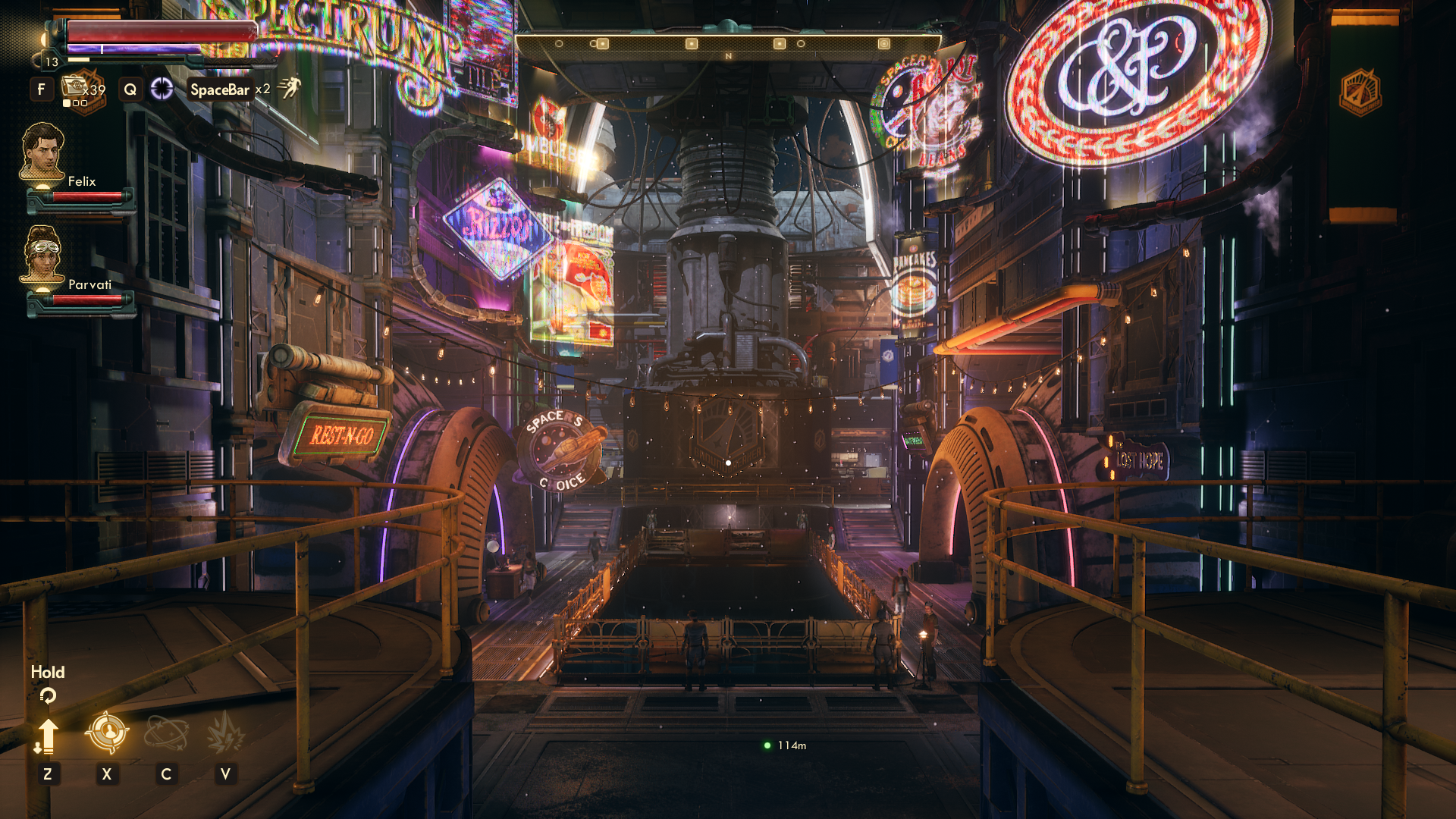Game: The Outer Worlds
Made by: Obsidian Entertainment
Published by: Private Division
Available on: Playstation 4, Windows, Xbox One
A limited-length RPG set in the caustically-corporate Halcyon system, The Outer Worlds aims to be Obsidian’s spiritual successor to Fallout: New Vegas.

CONTENT
Microtransactions: None
Tedium: Little — Equipment Repair
Violence: Moderate
Graphic Content: Mild Blood & Gore
CONCEPT
In stasis high above the Halcyon System, the interstellar pilgrims of the colony ship Hope remain trapped in an indeterminate period of cryosleep. The people of Halcyon, ruled by a cabal of corporate overlords known as The Board, believe the Hope went missing years ago. Now, by the machinations of the rogue scientist Phineas Welles, you are the first of the Hope‘s colonists to be unfrozen, and possibly the last… hope for the Halcyon System. Build your character, find a spaceship, and lay waste to the board. Or become its newest member.
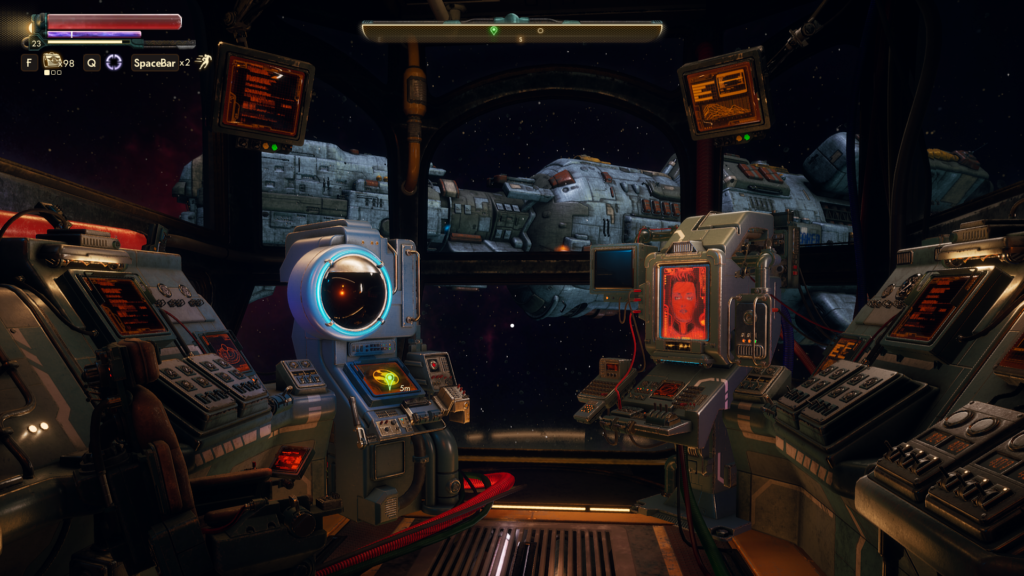
OVERVIEW
The Outer Worlds has earned a reputation as a “short” RPG. Sometimes lauded as a boon to the overworked gamer without enough time to complete a behemoth of Skyrim‘s repute, it also evokes the question of whether or not a “short” RPG is worth the title’s $60 price tag.
Now, cards on the table, I cheated a little bit here by making use of Xbox Games Pass and its $1 first month pricetag to play The Outer Worlds (made available on the service on launch day), but this is a game whose worth doesn’t come from its playtime in hours, but how densely packed each of those hours is with genuine enjoyment.
The Outer Worlds is an RPG without the bullshit. Obsidian and Private Division are serious about the (silly) world they’ve created, and they don’t feel the need to pressure you to spend any more time in it than you need to to save (or destroy) it. The fetch quests are limited, there aren’t extraneous dungeons littered around the map, and the space between objectives is limited. What this creates is an experience that’s wholly to-the-point without taking away from the overall feel of the game. The Outer Worlds doesn’t string you along in order to justify its pricetag. Instead, it hopes the story it has to tell is worth it enough.
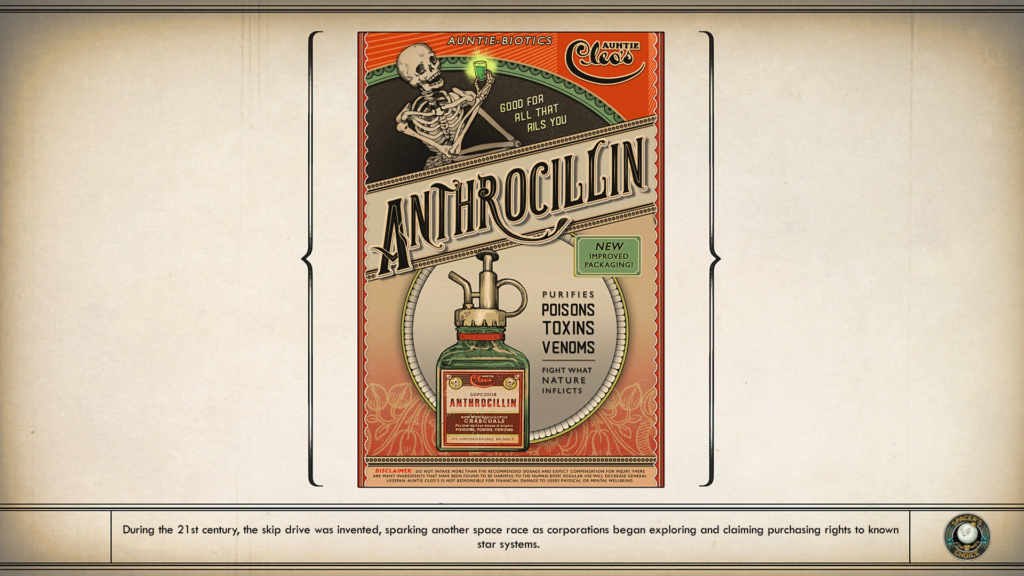
There, though, it’s worth entertaining that each of these changes may not be for everyone. For some, fetch quests contribute to the relaxing immersion-building necessary for a full-price RPG. Similarly, a wide-open game map populated with plenty of dungeons may be necessary to develop the feeling of a real, living world. Some people are perfectly happy with these traditional experiences, and it’s worth acknowledging how the unique take of The Outer Worlds may be uncomfortably unusual at first. Make no mistake, though, against the (potential) theme of its story, The Outer Worlds is not a revolution in the RPG space as much as it is a much-needed reinterpretation of the medium, one that challenges our idea of what a $60 RPG is.
With The Outer Worlds, Obsidian and Private Division artfully distill the modern role-playing game into a more easily-digestible format by devoting resources to enhancing the moment-by-moment experience. It’s a game I really enjoyed over the couple of weeks I took to play and complete it.

WHAT I LIKED
Skills System — The Outer Worlds‘s skill system is the Fallout 3 skills system with a couple of tweaks in execution. For those who didn’t grow up exploring the Capital or Mojave wastelands, each character has a set of 18 skills divided into seven skill categories. Each skill has a level from 1 to 100 that determines the player character’s effectiveness in its domain. Skill points can be allocated at the beginning of the game each time your character levels up, which affords you ten additional points. Initially, skill points are applied on a category-wide basis, meaning a point applied to the “Dialog Skills” category is applied simultaneously to the Persuasion, Lie, and Intimidate skills. This process continues until the individual skills reach level 50, at which point skill points are applied on a more specialized skill-by-skill basis.
From here on out, the system borrows a lot from Fallout, but differs in a few key ways. Perhaps most notably, some of Fallout‘s traditional skills, such as Speech and Melee, have been blown up into multiple specialized skills (in this case Persuasion, Lie, and Intimidate for Speech and One-Handed and Two-Handed options for Melee). How significantly this impacts the game is up to your playstyle, but as someone who typically chooses the charismatic, “talk your way out of a gunfight” angle, the change makes a pretty clear difference. Gone is the era of the universally silver-tongued man in favor of the more specialized persuader, liar, or intimidator.
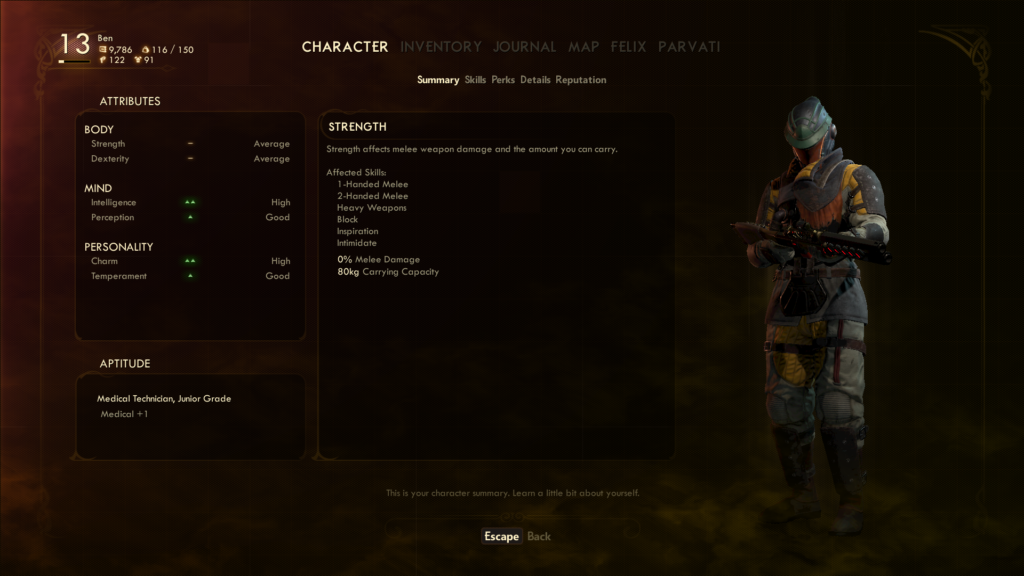
The system also changes up Fallout‘s in its interpretation of the lockpicking and hacking skills. Here, The Outer Worlds does away with its spiritual predecessor’s minigames in favor of a simple “Hold E” prompt, which, depending on your position, is either a decision to go down the less interesting route or the removal of unnecessary bloat. I think they’re kinda fun, but that’s an opinion thing. The more interesting change here is that the “difficulty” of each pickable lock and hackable terminal is displayed numerically, generally a number divisible by five. This represents a change from the Fallout system where locks were given categorical difficulties ranging from “Very Easy to Very Hard” and allocated skill points were effectively useless until they hit the threshold for the next category (generally every 25 points). This makes both skills a little more accessible at any level. Skills can’t be changed through perks, but armor and companions can boost (or, in the case of some heavy armors, lower) individual skill levels.
Finally, as strong as the skills system in The Outer Worlds can be, it’s sometimes undercut by some of the game’s other systems. For example, the game’s fairly easy combat makes some of its weapon skills unattractive, with leadership skills (which increase the combat effectiveness of companions) following suit. Similarly, while most are pretty clearly delineated, some skills are clearly lacking in comparison to their more robust brethren. I went through the whole game, for example, assuming that the Science skill would help me out with plasma weaponry, only to find out relatively late in the game (and 60+ Science points deep) that Science Weapons are relatively rare pieces of novelty equipment that function more as status modifiers than realistic killing machines. To be fair, the game does specifically denote the associated skill in each weapon’s description, but illiterate damage fiends like myself might find themselves victims of unstated deception.
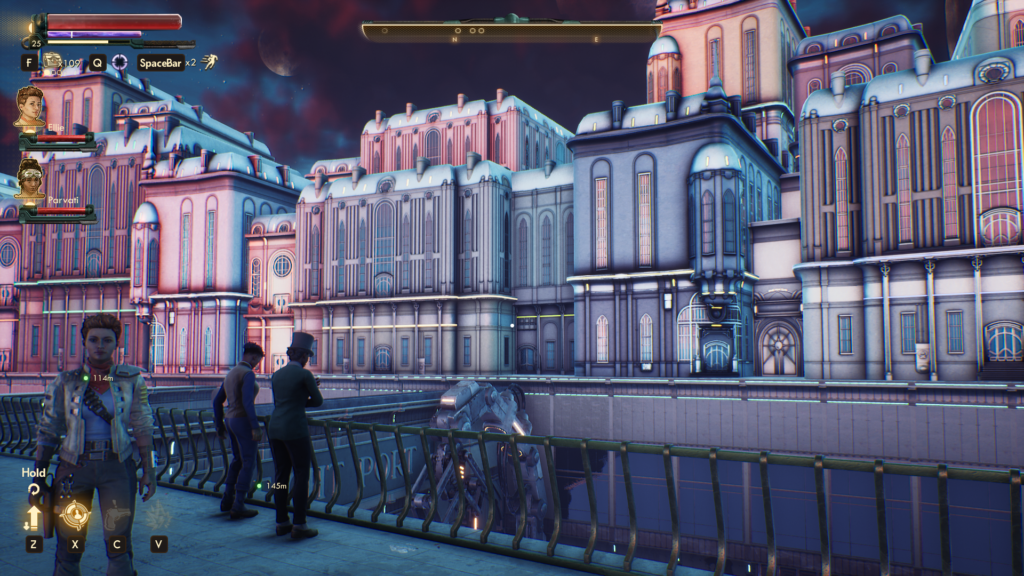
Companions — If there’s a game that does companions better than The Outer Worlds, I haven’t played it. Each of the game’s six tagalong friendlies feels wonderfully fleshed out and realized where others have historically fallen flat. Each one responds independently in conversations with NPCs, sometimes responding to one another. In the field, they regularly converse, with a plentiful enough supply of dialogue that I’m fairly certain I never heard the same conversation twice. The game allows players to travel with up to two companions (or none at all) at any given time. They’ll comment on the world around them, the story at the current moment, and the decisions you make as the player. Some of their most veritable charm comes from their interactions on the ship (the game’s hub), which contribute to a living atmosphere.
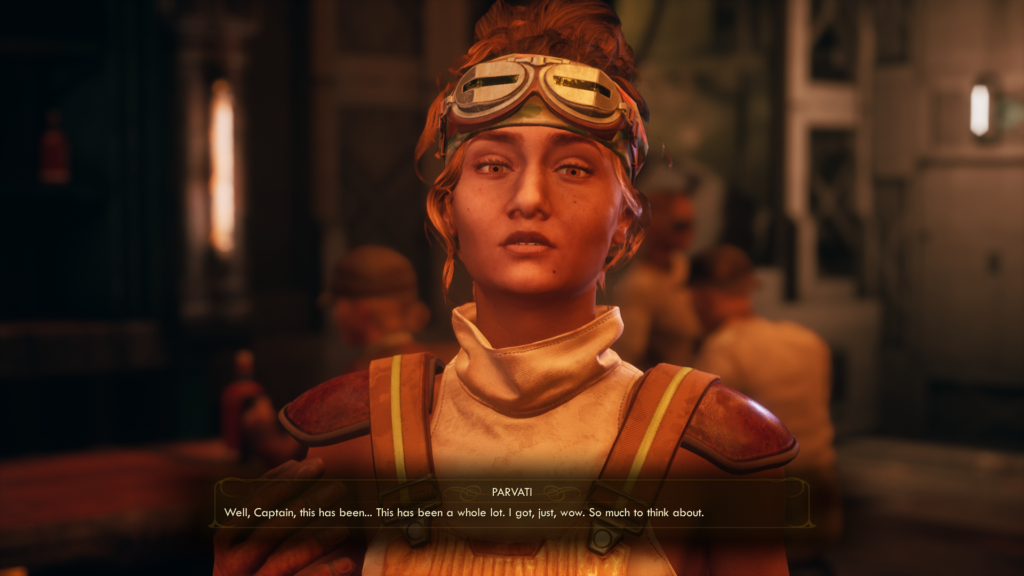
Each of the individual characters comes with a questline and backstory, and most of them are pretty solid in characterizing and selling the companion as a part of the game’s world. That established, each of these stories is only as deep as the game allows, and, being that this is a relatively short RPG, the experience is naturally limited. Again, though, these are companion characters that feel more like they belong in their universe than most. Playing without any of the companions in your party is both possible and capable of being balanced against through the perk system, but to remove them from your playthrough is to cut out one of the game’s most successful pieces of character.
Beautiful World — The downside of The Outer Worlds’s relatively small maps is pretty clear. The upshot, though, is the level of artistic detail each zone comes with. The bright rings and chromatic sunsets of Terra 2 perfectly illustrate the feeling of a first voyage on this alien world. The tall buildings and immaculate City streets of Byzantium are as captivating as they are inaccessible. Even the surface of the asteroid Scylla is given a surprisingly eye-catching atmosphere with attention to the details of the violet sky. The graphics of The Outer Worlds aren’t necessarily cutting edge (though they are indisputably modern — this is by no means an outdated game), what the game’s graphical minds manage to do with its world and engine is nothing short of art. It’s a world(s) I’d love to see more of.
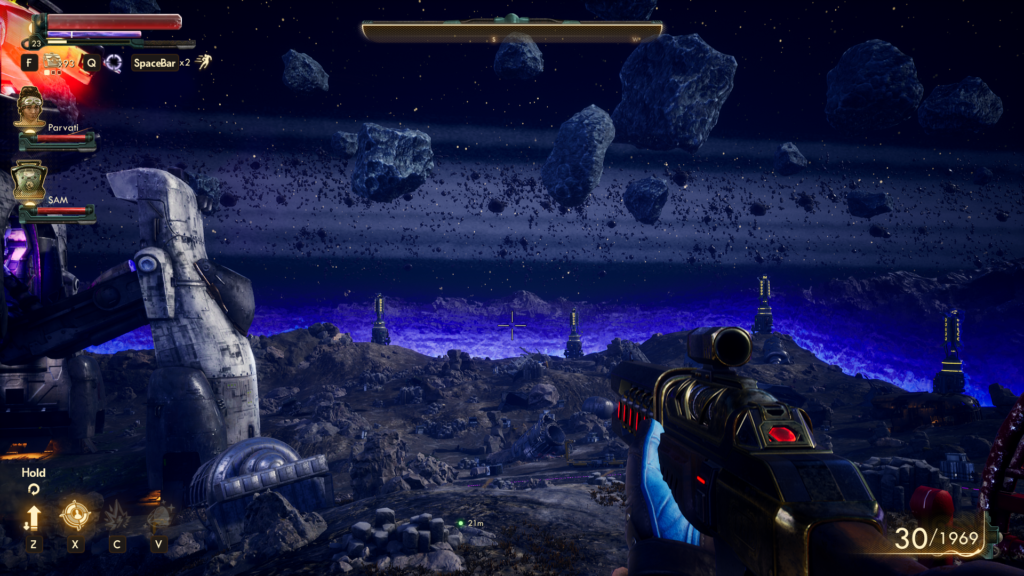
Smooth Looting — Years later, the Fallout 4 innovation I can’t stop talking about is the streamlined looting system. Rather than opening containers and searching dead enemies with one keypress, filtering through be a menu, and backing out with another, the game instead showed loot pools in real time when players hovered over the lootable object in question. It’s a feature I absolutely cannot fault The Outer Worlds for borrowing. The system works exactly as it did in Fallout, but with a few key upgrades. In addition to the ability to loot items from the easily-accessible menu, players can also scrap lootable weapons and armor for parts without scrolling through menus and searching for whichever obscure helmet they looted from a crate somewhere. I mean, it still happens sometimes, but then it’s a little more on you.
Quest Organization — Given the many-worlds setting of The Outer Worlds, adequate quest organization may be a must. The game allows you to sort quests by type (main, side, companion, and task) or by location, which makes planetary completion a breeze. Without this option, I’d have definitely been more liable to complete a few quests on one planet and travel to another, only to later find one that I missed hiding somewhere in my questlog. That said, there are still some notable kinks in the system; sometimes quests are organized by where you received them rather than where they’re active, for example. Still, it’s better than the alternative.

COULD BE BETTER
Perk System — Borrowing a staple from most big-name RPGs, The Outer Worlds allows players to choose a perk from a tiered list once every other level. Each perk offers a slight upgrade to gameplay, ranging from increasing the length of the time-dilation meter to enhancing damage done without companions to increasing carrying capacity. With a level cap at 30 and dozens of perks to choose from, there’s a natural limit on how many of these upgrades you can apply, but the game offers an additional bargain in the form of flaws. Throughout the game, whenever your character takes enough of a beating to cross a hidden threshold, you’ll be offered a flaw. Players who take too much plasma damage may be offered a natural weakness to plasma, those scarred significantly by raptidons can be offered an inborn fear of the species. Each of these flaws decreases proficiency in one area of gameplay in exchange for an additional perk point, which is a really interesting system not similarly taken advantage of in recent RPG titles.
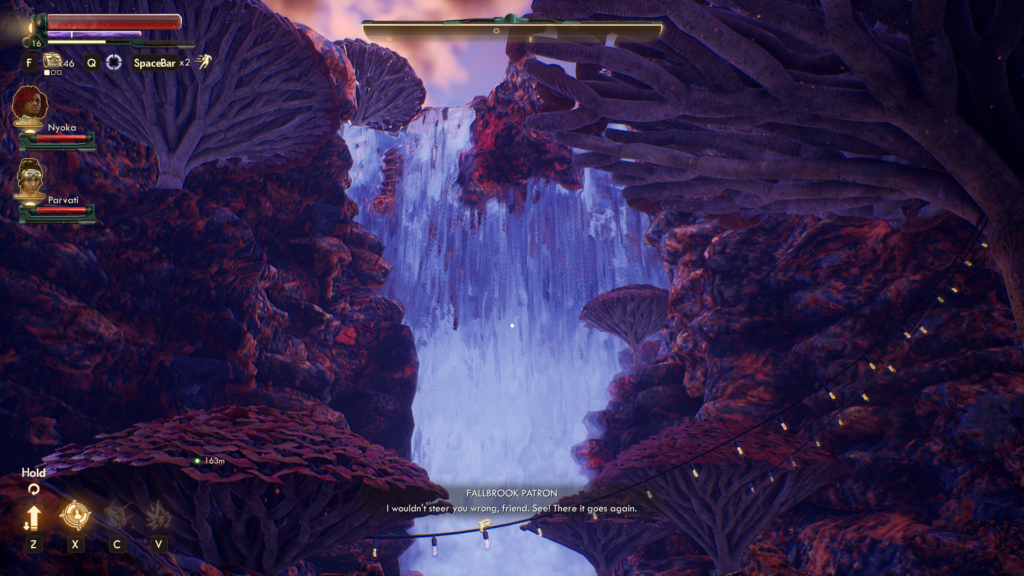
Unfortunately, the value of the perks break it. While not entirely useless, the perks aren’t ever really attractive enough to justify handicapping your character in any way to claim another. Over my playthrough, I accepted a single flaw in the form of melee weapon deficiency, but every other offer presented itself as an uneven trade. Something like additional skill points may have brought more to the table.
Lack of Animal Diversity — One of the unique privileges of a game set across multiple planets is an unlimited degree of setting diversity. Color, gravity, and life are all at your command through every step of the development process. As gorgeous as each of The Outer Worlds‘s planets are, I can’t help but be moderately disappointed at the lack of faunal diversity. The number of creatures in the Halcyon system is limited — not too few for an RPG the size of The Outer Worlds, but maybe for an entire solar system. Between the Primals, Mantisaurs, Raptidons and Sprats, all species seem to share the same ecological niche that is the entire Halcyon system. This as opposed to a more realistic view of individual planets that each played host to their own unique sets of plant and animal life.

The decision to use a standard set of animals for each of Halcyon’s planetary bodies doesn’t take too much away from its otherwise-strong worldbuilding, and it might have even been the smart decision from a gameplay perspective (especially given that each planet has a relatively small footprint in the game at large), but it’s nonetheless a minor disappointment to those of us hoping for a little bit more depth from the game’s setting.
Gameplay Outpaces Mechanics — Altogether, the pacing of The Outer Worlds is well-designed. The game knows it’s a limited-scale RPG, and most of its design lends itself well to the format. Some individual mechanics, though, like weapon and armor modification, feel like their utility is slightly outpaced by gameplay progression. I found the game’s weapon upgrade system, for example, to be engaging, but I always felt a nagging sort of worry that I’d find a better weapon or armor soon after upgrading my current one, rendering it (and my effort) obsolete. Realistically, the game doesn’t have too many weapon tiers but it also doesn’t do much to indicate the pace at which better ones drop. Overall, upgrading to fit your playstyle is always worth it, but (because an individual upgrade pieces can only be applied once) avoid growing too attached to rarer upgrades.
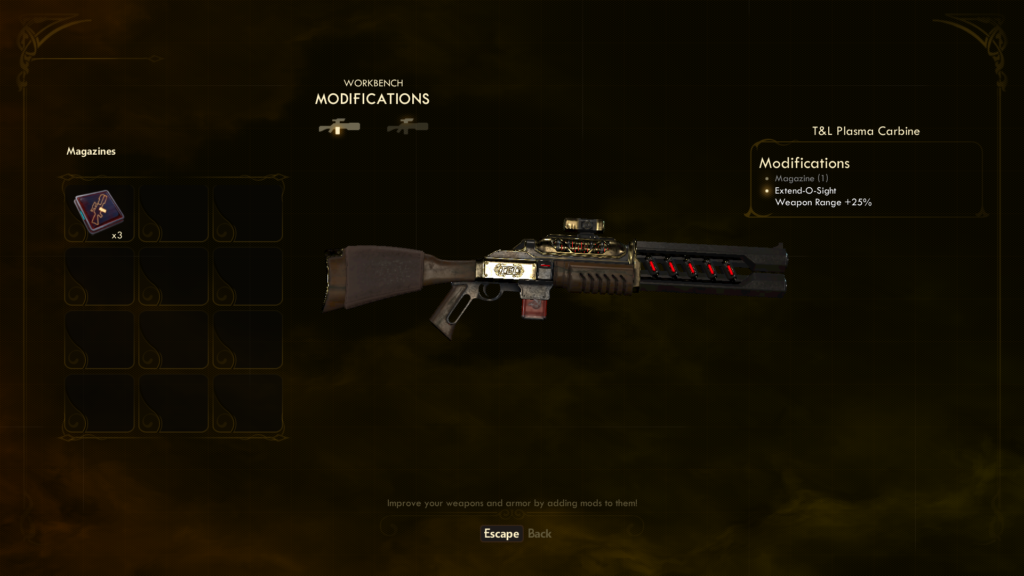
CONCERNS
Combat Difficulty — This is the big one. I can’t underscore enough that The Outer Worlds’s combat isn’t bad, it’s just… pretty easy. To be fair, I played on the game’s Normal difficulty, one below Hard and two below the gameplay-shifting Supernova, which adds survival challenges and makes companions killable. Still, after a certain point, most challenge was negligible, even with my skills poorly allocated to combat capabilities. Some of the title’s innovations, such as the inhaler that lets you preload drugs for easy access and the understated Chrono-dilation mode (a sort of VATS-y take on bullet time) fall by the wayside in that the lack of difficulty renders them a touch unnecessary on lower difficulties. It wasn’t until I completed The Outer Worlds that I started to feel I’d missed a chunk of it. The game’s gunplay is closer to Fallout 4 than the comparatively weaker combat mechanics of 3 and New Vegas, and while taking out groups of Marauders and alien lifeforms is (in my opinion, obviously) still a fun experience, dedicated shooters are likely to find it lacking.
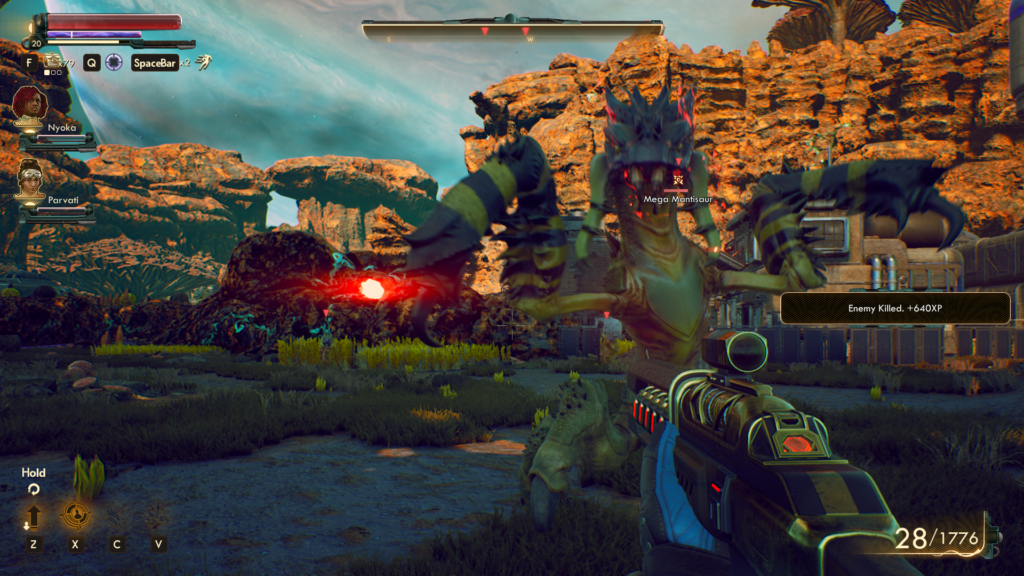
Bugs — A spiritual successor to Bethesda RPGs like Skyrim and Fallout 3 shipping without bugs may as well be a faithless adaptation. In their endeavor, though, Obsidian and Private Division have managed to (in my experience) craft a nearly spotless game. But “nearly spotless” isn’t entirely spotless. Now, to be fair, a skipped frame or bugged animation here or there isn’t really reason for alarm, and I only really experienced one or two notable bugs throughout my playthrough. The most major of these, though, was one that hit seemingly at random and decided that Parvati, my favorite of the game’s six companions, was permanently dead and her questline incompletable. Now, to be fair, she wasn’t dead; I could still take her with me on planetary expeditions, initiate conversations with her, and listen to her interact with other companions and the world. But somewhere in the game’s files, she was dead. This meant I was unable to complete her companion quest and that, at the end of the game, when the classic narrated slideshow plays and explains how the world fared post-me, Parvati’s potential epilogue was replaced with “Parvati did not survive her adventure with you.” a disappointing mark on an otherwise positive narrative experience.
Update: In the week(ish) since this review was published, Obsidian fixed this particular issue and some of the game’s other bugs.
Inconsistent Minor Mechanics — This is the “other” section of the review. There are a couple of minor mechanical issues that caused me some frustration late in the game. The first I haven’t yet been able to identify as a bug or a poorly-implemented feature. The game’s stealth system is an interesting one. Acquiring the holographic shroud (which happens early on) allows for a temporary undetectable period behind enemy lines. The shroud runs on a timer, and once it’s run out, you’ll need to exit the forbidden area and re-enter to reset its ability. I found myself more than once in the city of Byzantium exiting one of those forbidden zones undetected, only to find the associated guards target and attack me later on. In some cases, this was reset by exploiting the game’s “sleep three days and all is forgiven” rule, but there’s one level of a particular tower that acted as a negative reputation engine, requiring a sprint through each time to keep my companions from killing potentially-important NPCs (note: the game does allow you to modify the aggressiveness/passiveness of your companions, but I’m all about the freedom of it, you know?)
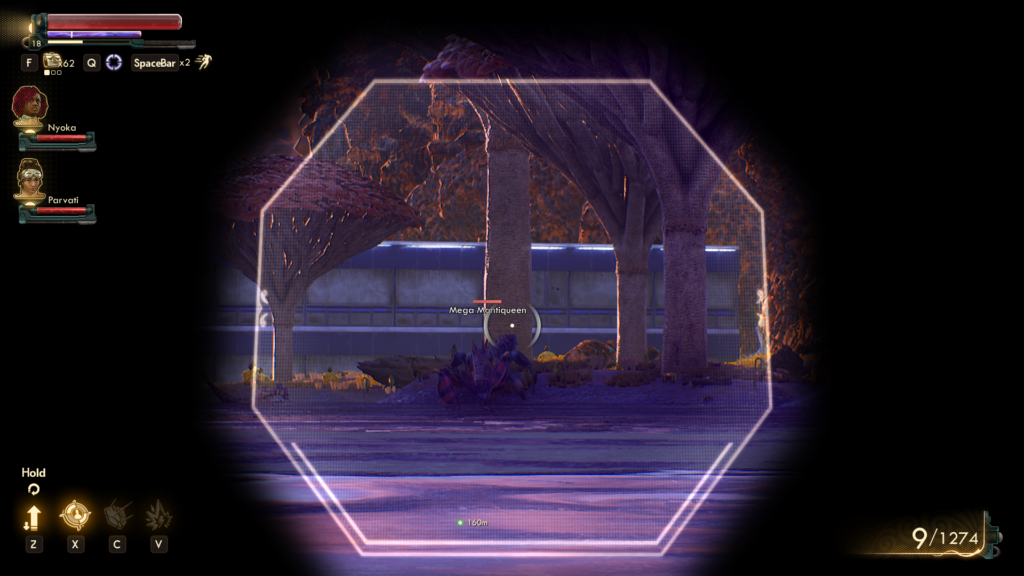
The other issue I had was a minor change in the direction of story-related conversations toward the very end of the game. I’ll steer clear of any real spoilers, but here’s the basic background: near the game’s end, a faction leader offered me a quest to undo some of the good I’d done earlier on by indirectly causing the deaths of some of the game’s characters. I’d come to this point through deception, telling this character I was on her side while acting in the other’s favor. Up until here, the game had encouraged this approach. So when I told her I’d clean up her people problem, I was slightly surprised that I couldn’t either turn on her to the benefit of the opposing faction or explain that intent to the members of my crew. Instead, for the remainder of the game, each treated me like a turncoat abandoning my cause, despite never having acted to complete the quest. It was a minor distraction that occurred very close to the end of the game, but it acted to disrupt the immersion I’d built so far.
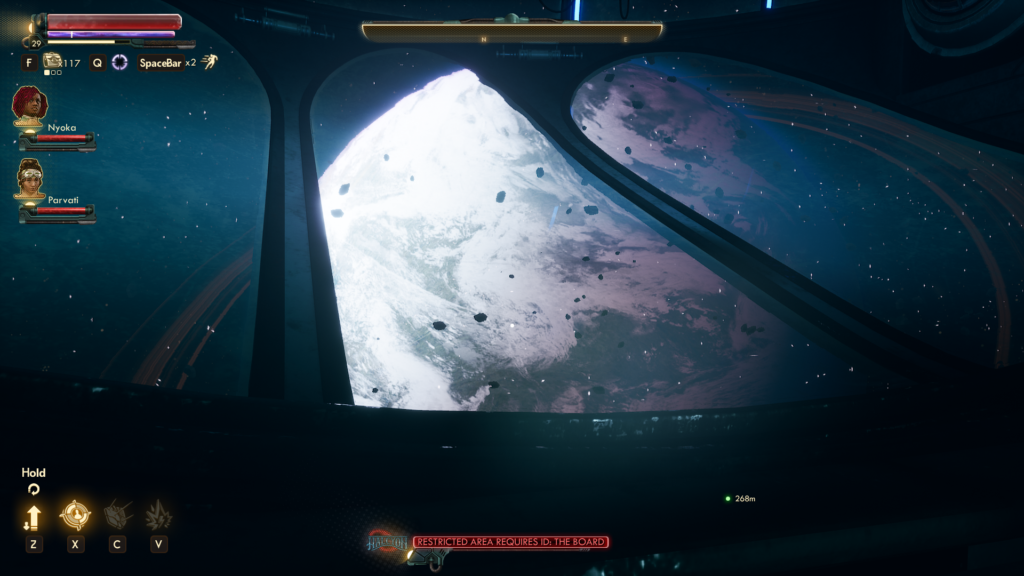
WHO’S IT FOR?
If you enjoyed Fallout: New Vegas and you’re willing to try a slightly shorter, more linear experience, The Outer Worlds is probably for you. Similarly, if you’re a fan of role-playing games at all and don’t mind one that’s a little shorter but still packed with the features and development focus of a 2019 triple-A title, there’s a good chance you’ll enjoy this game.
Alternatively, if you’re someone who expects 100+ hours out of your next RPG fix, someone looking for a broad open world, or someone who traditionally doesn’t enjoy role-playing games or shooters, this might not be the title for you.
